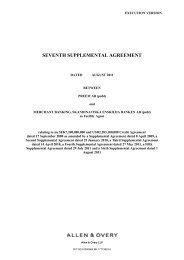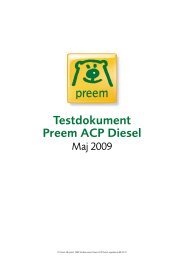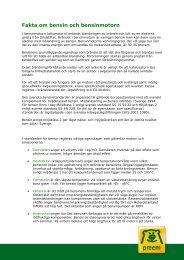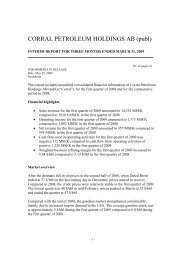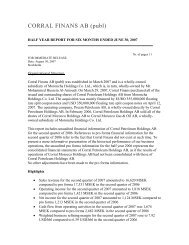Corral Petroleum Holdings AB (publ) Business Update ... - Preem
Corral Petroleum Holdings AB (publ) Business Update ... - Preem
Corral Petroleum Holdings AB (publ) Business Update ... - Preem
Create successful ePaper yourself
Turn your PDF publications into a flip-book with our unique Google optimized e-Paper software.
SalesOur supply and refining segment exports over one half of its products each year (approximately 68% in 2009 andapproximately 64% in 2010). For 2011, we anticipate that our export share will be as high as or slightly higher than in 2010.Our exports are primarily to northwest Europe, including to other countries in Scandinavia, France, Germany and the UnitedKingdom. In 2010, our supply and refining segment sold approximately 80% (by value) of its products to third parties and20% (by value) to our marketing segment. With respect to third-party sales, we sell our refined products on the spot marketand pursuant to sales agreements with terms generally not exceeding 12 months. Our third-party customers arepredominantly other oil companies, including <strong>AB</strong> Svenska Statoil and OK-Q8 <strong>AB</strong>. We sometimes sell liquefied petroleumgas and naphtha to petrochemical companies. All third-party sales of gasoline, jet fuel and diesel are sales to other oilcompanies or traders. Approximately 90% of our third-party sales of heavy fuel oil are sales to oil companies, bunkerdistributors in the local market and traders, with the remaining 10% sold directly to industrial customers.Raw MaterialsSupply. We purchase the majority of our crude oil on the spot market, which provides us with flexibility inobtaining a supply of crude oil that is in line with our raw material requirements. This allows us to take advantage of therapid price fluctuations in the crude oil supply market through our crude oil purchasing strategy. This strategy involvesregularly monitoring market conditions for various types of crude oil as well as demand for refined products. Our objectiveis to minimize production costs (cost of crude oil, transportation and refining) and maximize sales revenue from the sale ofthe refined products that are most in demand. We occasionally supplement this purchasing strategy with various hedginginstruments and forward sales contracts on refined products when we believe it would be more beneficial to reduce the effectsof fluctuations in crude or refined product prices.Price Effect on Inventories. We hold large inventories of crude oil and refined products and, thus, our financialresults are impacted by the effects of fluctuations in the market prices for crude oil and refined products. To the extent thatcrude oil and refined product prices rise in tandem, our gross profit would generally be positively affected because wecompute the gross profit as the excess of sales revenue (determined at the time of sale at the higher refined product prices)over the cost of goods sold (determined at the earlier time the crude oil is purchased at lower prices). Conversely, a portionof the gross loss that we record during a period of falling prices may be attributable solely to the decrease in prices during theperiod after we buy the crude oil and prior to the time we finish refining it and sell it.However, during periods of rising crude oil prices, the cost of replenishing our crude oil inventories and, thus, ourworking capital requirements similarly increase. Because changes in refined product prices tend to lag behind changes incrude oil prices, we generally experience the increased working capital requirements from higher crude oil prices sooner, andto a greater degree, than the benefits to our gross profit that may arise from selling products at higher refined product prices.Depending on the rate and the duration of the increase, and the degree to which crude oil prices move more thanrefined prices, our gross profit margins may actually decline during periods of rising crude oil prices. During periods ofdeclining crude oil prices, we believe that we experience the opposite effects. Both the crude oil market and the refinedproducts market are volatile.We believe that, although the price effect on inventories may impact our results for a given period, over the longterm,the effects of rising and falling oil prices tend to offset each other. In addition we believe that, from a cash flowperspective, the effects of rising and falling oil prices on gross profit and working capital tend to offset each other.Therefore, in comparing our results from period to period, we believe that it is important to note that these price effects oninventories are unrelated to, and do not reflect, the underlying efficiency of the refineries. See also “Management’sDiscussion and Analysis of Financial Condition and Results of Operations—Quantitative and Qualitative Disclosures aboutMarket Risk—Commodity Price Risk” included elsewhere in this <strong>Business</strong> <strong>Update</strong>.Inventory Management. We employ several strategies to minimize the impact on our profitability of the volatility infeedstock costs and refined product prices. Our inventory management strategies include the purchase and sale ofexchange-related, oil-related futures and options with a duration of 12 months or less. To a lesser extent, we also use oilswap agreements similar to those traded on international exchanges such as the ICE Futures Europe, including crack spreadsand crude oil options that, because they contain certain terms customized to the market in which we sell, such as point ofdelivery, are better suited to hedge against the specific price movements in our markets. The number of barrels of crude oiland refined products covered by such contracts varies from time to time. Nevertheless, we seek to maintain our “normalposition” of crude oil, finished products and intermediates. Our “normal position,” which is 1,840,000 cubic meters(approximately 12 million barrels), is evaluated based on the average optimal inventory level in our depot system, therequired inventory levels to allow for continuous flow and operations and the amount of crude oil and products that arepriced, but not delivered. When the volume in our inventories deviates from the normal position, both above and below, we43



